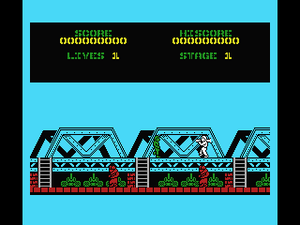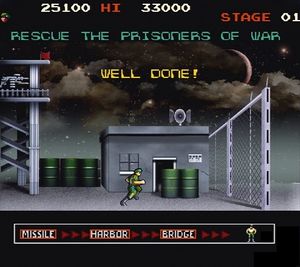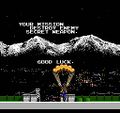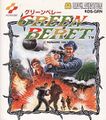Amstrad CPC


Ported by Imagine software and released for sale in the United Kingdom in 1986.
Atari XL/XE

Ported by Imagine software and released for sale in the United Kingdom in 1986. Considered a glitchy and rather poor conversion.
Commodore 64
Ported by Imagine software and released for sale in the United Kingdom in 1986. Later rereleased for sale by The Hit Squad in 1989.
-
Screen
-
Original box
-
Reissue box
Famicom / NES
Originally developed for play on the Famicom Disk System by Konami and published in 1987, featuring a different plot, a new introduction, a new ending, two additional stages, the removal of flame throwers, but the addition of two new weapons in the third stage (invincibility star and the pistol). See the rest of the guide for more information. The Japanese version also features a secret underground tunnel in the fourth stage, however this tunnel was removed when the NES version was released. The NES version sports the name Rush'n Attack in the US and in Europe.
-
New Intro
-
Famicom Disk System cover
-
NES box scan
MS-DOS
Published by Konami for sale in the United States in 1989.
MSX


Ported by Konami and released for sale throughout Europe in 1986.
Sinclair ZX Spectrum
Ported by Imagine software and released for sale in the United Kingdom in 1986. Later rereleased for sale by The Hit Squad in 1989.
Xbox Live Arcade


Ported by Digital Eclipse software and released for download on the Xbox Live Arcade in 2007. Just as before, the American version is called Rush'n Attack, and the Japanese version is called Green Beret, however the European version was given the Rush'n Attack name, possibly due to more players being familiar with that name from the NES version. The game can be played with the original graphics unaltered, or in an enhanced mode where the background graphics are presented as 3D models, and the foreground sprites are heavily filtered to give them a higher resolution look.





